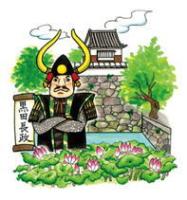Hakata Culture vol.7
Fukuoka Castle - Behind The Walls

Fukuoka residents don't think twice about it, but there are actually two names for Fukuoka City. The locals don't seem to make a clear distinction between the names Fukuoka and Hakata, but the Hakata name is well known among people outside of Fukuoka, and particularly among those outside of Kyushu. Nevertheless, the Fukuoka name was first used during the Edo period (1603-1868), and Fukuoka City became the official name during the Meiji period that followed. Therefore, the Hakata name has been used for a considerably longer period of time.
The site now familiar to city residents as Maizuru Park was once the location of the Fukuoka Castle, which took the first daimyo, Kuroda Nagamasa, seven years to build, starting in 1601. The efforts of Nagamasa and his son, Kuroda Josui, in the Battle of Sekigahara contributed to the victory of Tokugawa Ieyasu, who rewarded them with the Chikuzen fief that yielded 523,000 koku of rice (or more than one million U.S. bushels). The original residence of the Kuroda feudal lords was Fukuoka in Bizen, now Okayama prefecture, so they called their new home Fukuoka Castle. That's how the region around the castle came to be known as Fukuoka. When viewed from Hakata Bay, the castle seemed to soar like a bird in the sky, hence the name Maizuru Castle, or "The Dancing Crane."
In those days the castle was a magnificent structure-”there were moats extending inland from the sea, and it had more than 10 gates and 47 turrets. The stone walls were also very imposing, having been built by well-known masons who had helped build the Osaka Castle. Therefore, it also was called Sekijo, or the Stone Castle. Visitors can see the Minamimaru Tam on turret and the impressive wall, which have both survived until present day.
Built in the center of the city, Maizuru Park is a favorite spot among the city's residents for its floral beauty throughout the year. In addition to being renowned as a location for viewing cherry blossoms, the park also has several varieties of peony, wisteria, iris, and hydrangea. In the summer, the entire moat is filled with lotus in bloom.
There are still too many people who don't seem to be aware of Fukuoka history, including that of the Kuroda domain and the Fukuoka Castle. You'll be thrilled at all the discoveries that await you at Maizuru Park.
For more details, be sure to check out this website.![]() http://www.mori-midori.com/sisetsu/10maizuru/
http://www.mori-midori.com/sisetsu/10maizuru/
A public relations manager
Kimiyo Sasaki
福岡の名前、もともとは岡山県の地名です
福岡に住んでいると当たり前のように思ってしまいますが、福岡市には二つの呼び名があります。「福岡」と「博多」、明確な呼び方の差はないような気がしますが、福岡以外の人、特に九州以外の人には「博多」の名前が有名です。というのも、福岡と地名が付いたのは江戸時代以降だし、福岡市と決定したのは明治時代からなので、博多と呼ばれた時代の方が圧倒的に長いのです。
現在は舞鶴公園として市民には親しまれていますが、ここに初代福岡藩主・黒田長政が1601年(慶長6)年から7年がかりで福岡城を築城しました。黒田如水・長政親子は関ヶ原の戦いの功績によって筑前52万3000石を徳川家康より与えられました。黒田の殿様がもともと住んでいたのが、備前国(現在の岡山県)の福岡だったことから、自分たちが住み始めた城を福岡城と名付け、そのあたり一帯を福岡と呼ぶようにしたのです。博多湾から眺めると、大空に舞う鳥のような姿の城であるため、別名・舞鶴城とも呼ばれました。
当時は海から続く堀をめぐらし、城内に10あまりの城門と47の櫓を配した壮大な城だったようです。また大阪城の築城にも参加した石積みの名人が造り上げた石垣が素晴らしかったため、石城とも呼ばれたとか。当時のまま残されている南丸多聞櫓や立派な石垣に面影を見ることができます。
都心の公園・舞鶴公園として整備された一帯は、ご存じのように桜の名所として有名なのはもちろん、ボタンや藤、シャクヤク、花菖蒲、アジサイ、そして夏になると堀には一斉にハスの花が咲き、四季を通じて美しい花々が咲き乱れる公園として市民の皆さんに今でも愛されています。黒田藩のこと、福岡城のことなど、福岡の方の歴史はまだ知られていないようです。ぜひ訪れて、勉強したいものですね。
舞鶴公園の詳しいことは![]() (財)福岡市森と緑のまちづくり協会ホームページ
(財)福岡市森と緑のまちづくり協会ホームページ
福岡市広報課長 佐々木 喜美代

